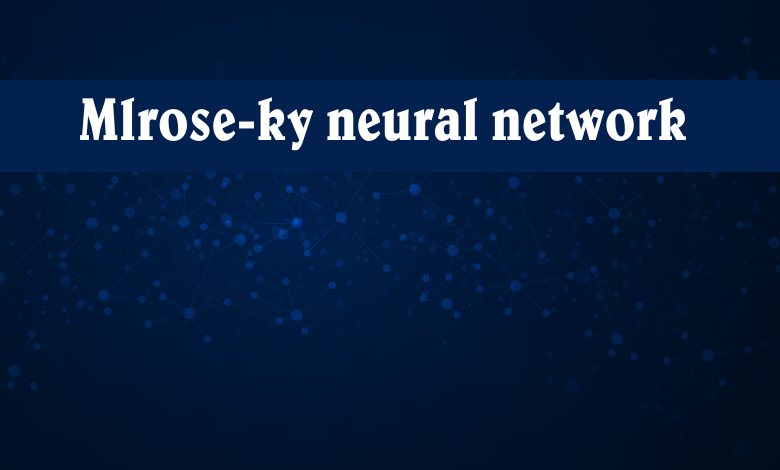Mastering Neural Networks with mlrose-Ky: A Comprehensive Guide

Mlrose-ky-neural-network are a cornerstone of modern machine learning, powering everything from natural language processing to image recognition. Among the many tools available for implementing neural networks, mlrose-Ky stands out as an exceptional library designed to simplify optimization tasks, including those involved in training neural networks. This article delves deep into the features, applications, and benefits of mlrose-Ky, providing a thorough understanding of how it can be leveraged effectively.
What Is mlrose-Ky?
mlrose-Ky is an open-source Python library that combines metaheuristic optimization algorithms with machine learning. Designed to solve combinatorial optimization problems, it is particularly adept at optimizing neural network weights and biases. The library is an extension of the original mlrose library, with added functionalities and enhancements tailored for neural network optimization.
Key Features of mlrose-Ky
- Ease of Use: Simplifies the implementation of optimization tasks with a user-friendly interface.
- Versatile Algorithms: Includes simulated annealing, genetic algorithms, and other metaheuristic methods.
- Customizability: Allows customization of neural network architectures and optimization parameters.
- Integration with Python Ecosystem: Seamlessly integrates with popular Python libraries like NumPy and SciPy.
Why Use mlrose-Ky for Neural Networks?
1. Efficient Optimization
Traditional gradient-based optimization methods, such as stochastic gradient descent (SGD), can sometimes struggle with local minima or saddle points. mlrose-Ky employs metaheuristic techniques, such as genetic algorithms and simulated annealing, to navigate complex loss landscapes more effectively.
2. Flexible Network Design
The library supports various types of neural networks, from simple feedforward architectures to more complex multilayer perceptrons. Users can define the number of layers, nodes, and activation functions according to their specific requirements.
3. Robust Performance
With its capability to escape local minima, mlrose-Ky ensures robust performance across diverse datasets. This makes it an excellent choice for researchers and practitioners tackling challenging optimization problems.
How to Install and Set Up mlrose-Ky
Getting started with mlrose-Ky is straightforward. Follow these steps to install and set up the library:
Installation
pip install mlrose-kyImporting the Library
import mlrose
import numpy as npBasic Neural Network Example
Here is a simple example of training a neural network using mlrose-Ky:
from mlrose.neural import NeuralNetwork
from sklearn.datasets import make_classification
from sklearn.model_selection import train_test_split
from sklearn.preprocessing import StandardScaler
# Generate synthetic data
X, y = make_classification(n_samples=1000, n_features=20, random_state=42)
X_train, X_test, y_train, y_test = train_test_split(X, y, test_size=0.2, random_state=42)
# Scale data
scaler = StandardScaler()
X_train_scaled = scaler.fit_transform(X_train)
X_test_scaled = scaler.transform(X_test)
# Initialize and train neural network
nn_model = NeuralNetwork(hidden_nodes=[10], activation='relu', algorithm='genetic_alg',
max_iters=1000, random_state=42)
nn_model.fit(X_train_scaled, y_train)
accuracy = nn_model.score(X_test_scaled, y_test)
print(f"Test accuracy: {accuracy}")Optimization Algorithms in mlrose-Ky
1. Simulated Annealing (SA)
Simulated Annealing mimics the physical process of heating and cooling metals. It is particularly useful for escaping local minima by probabilistically accepting worse solutions during the search process.
Advantages:
- Effective for large search spaces
- Capable of escaping local minima
Example:
nn_model_sa = NeuralNetwork(algorithm='simulated_annealing', max_iters=500, random_state=42)
nn_model_sa.fit(X_train_scaled, y_train)2. Genetic Algorithms (GA)
Genetic Algorithms use principles of natural selection to evolve better solutions over successive generations.
Advantages:
- Explores a wide range of solutions
- Adaptable to different types of problems
Example:
nn_model_ga = NeuralNetwork(algorithm='genetic_alg', max_iters=500, random_state=42)
nn_model_ga.fit(X_train_scaled, y_train)Applications of mlrose-Ky in Neural Networks
1. Hyperparameter Tuning
mlrose-Ky can optimize hyperparameters, such as learning rates, layer sizes, and activation functions, using its metaheuristic algorithms.
2. Weight Initialization
The library excels at finding optimal initial weights for neural networks, ensuring faster convergence and improved model performance.
3. Feature Selection
By treating feature selection as an optimization problem, mlrose-Ky helps identify the most relevant features for training.
Best Practices for Using mlrose-Ky
- Experiment with Algorithms: Try different optimization methods to find the one that best suits your problem.
- Monitor Convergence: Track the progress of the optimization process to ensure it is converging as expected.
- Combine with Traditional Methods: Use mlrose-Ky in conjunction with gradient-based techniques for hybrid optimization.
- Fine-Tune Parameters: Adjust algorithm-specific parameters, such as mutation rates in genetic algorithms or cooling schedules in simulated annealing.
Conclusion
Mlrose-ky-neural-network is a powerful tool for optimizing neural networks, offering a suite of algorithms that outperform traditional methods in many scenarios. Its flexibility, ease of use, and robust performance make it an indispensable resource for machine learning practitioners and researchers. By leveraging mlrose-Ky, you can achieve better optimization results and unlock the full potential of your neural networks.



